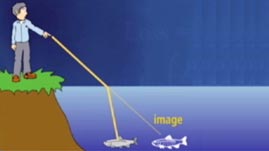Here are suggested ways to engage students with this video and with activities related to this topic.
- Beginning a lesson: Fill a small, clear plastic or glass tank with water. Shine a laser pointer through the water to demonstrate that the beam of light is difficult to see without an additive. Add a few drops of milk (or grains of milk powder) and stir so that the water is slightly cloudy. Direct the laser pointer into the water again and slowly change the angle at which the beam strikes the water. Which way does the beam bend? Ask students to observe the incident and refracted angles. Note: A slight water mist, baby powder, or chalk dust in the air over the tank makes the beam visible above the water's surface.
- Viewing the video: Use the following suggestions to guide students' viewing of the video:
- Before: Review with students how angles are measured in optics. Draw a diagram showing a surface and the normal (perpendicular) line, and indicate how the incident and refracted angles are measured.
- During: Ask students to pay particular attention to how the angles of incidence and refraction are measured. What does it mean to measure angles from the normal? How does the direction of the final beam segment compare to the direction of the initial beam segment?
- After: Ask students how they would react if someone handed them a piece of glass and told them that the index of refraction was less than one. What would that mean? If a student calculated index of refraction values of less than one using Snell’s law, what would the most likely error be?
- Doing a classroom activity: Provide students with cross-sectional drawings of biconvex and biconcave lenses. Indicate on the drawings the optical axis through the center of each lens and two rays of light entering the lens parallel to the axis (draw one ray above the axis and one ray an equal distance below the axis). Ask students to predict what will happen to the rays in each case. Do they bend toward or away from the normal as they encounter the surfaces of the lenses? After students have made their predictions on the drawings, show the Refraction of Light Demonstration.

 Loading Standards
Loading Standards Teachers' Domain is proud to be a Pathways portal to the National Science Digital Library.
Teachers' Domain is proud to be a Pathways portal to the National Science Digital Library.
